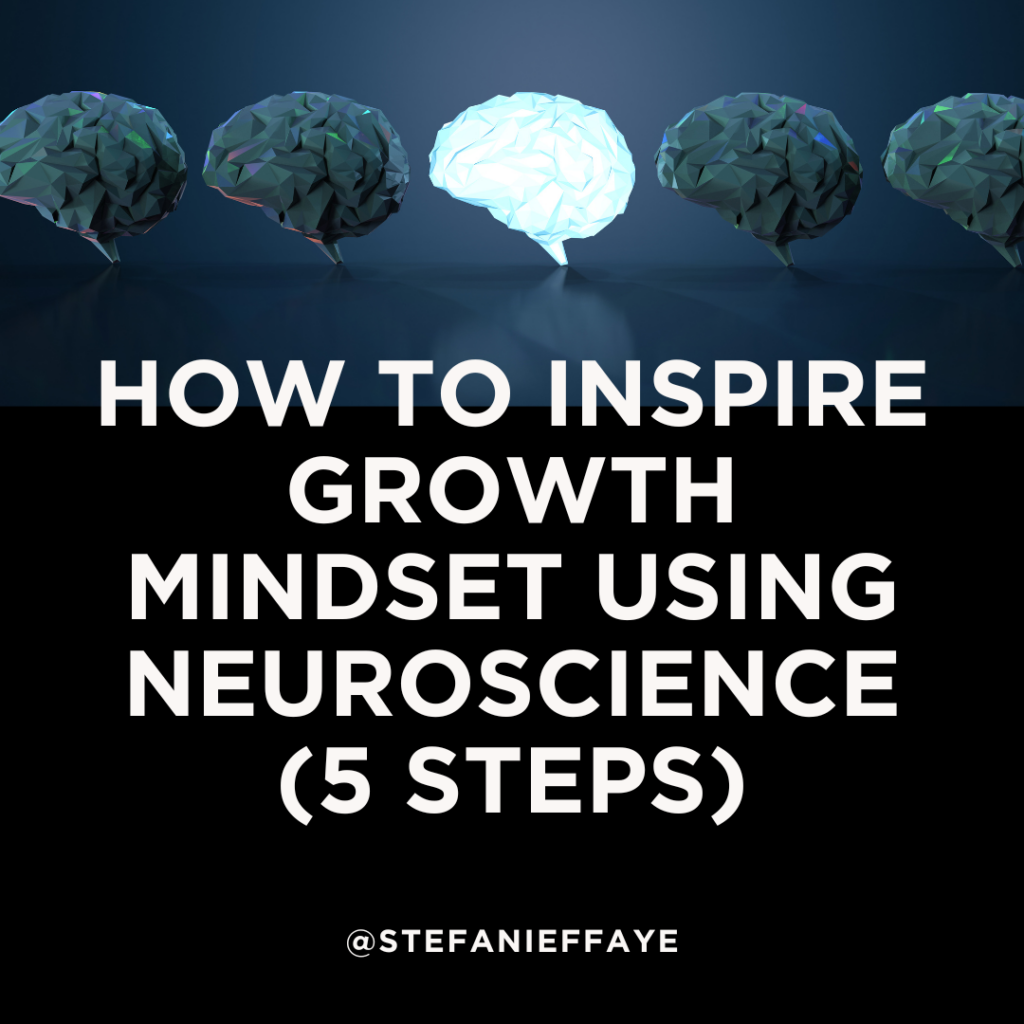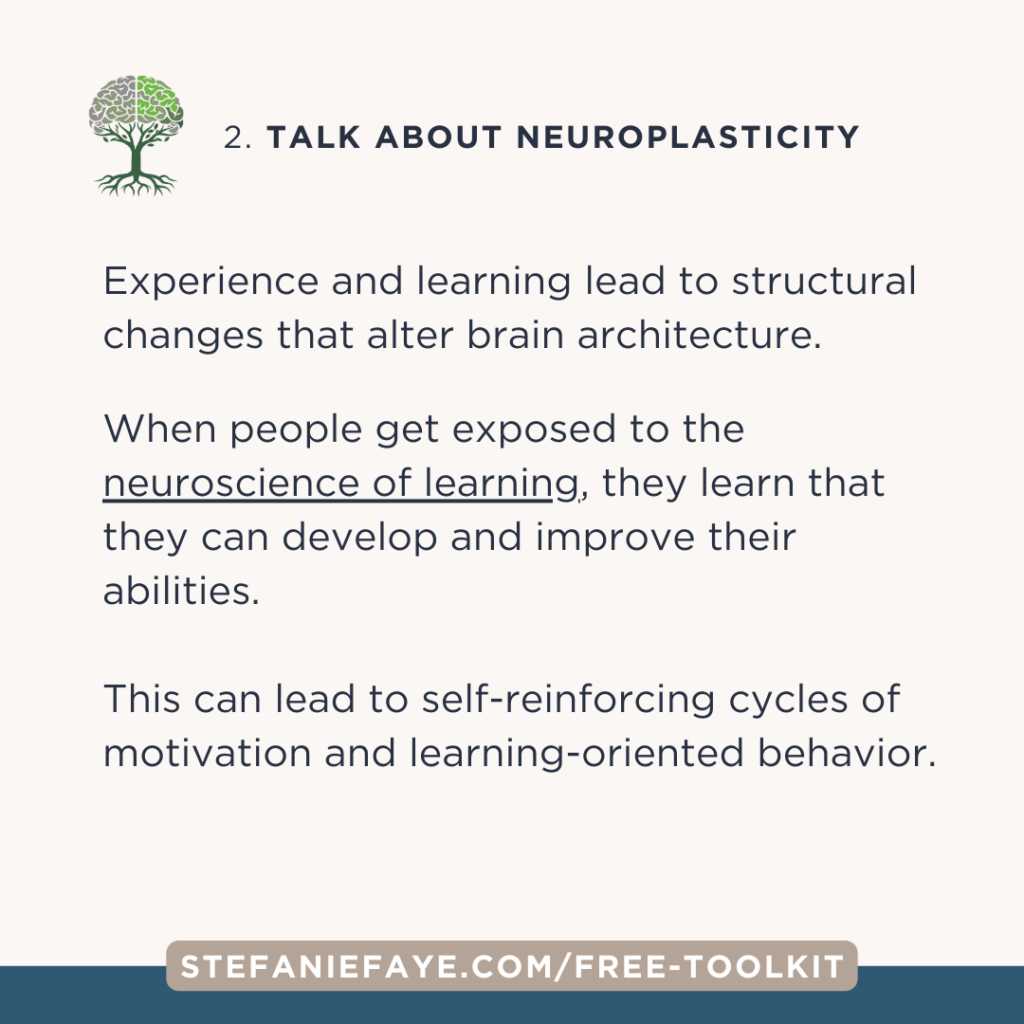"One thing about human intelligence is absolutely certain: it is malleable, meaning it can be changed through exposure to new information or even by looking at what you already know in a new way. There is no limit to what you can learn, and, contrary to what some may think, nobody's brain has ever been "filled."
-Terry Doyle and Todd Zakrajsek, The New Science of Learning: How to Learn in Harmony With Your Brain

Growth mindset neuroscience is about a belief in the changeability of the human brain and our ability to increase our intelligence and abilities.
As MIT’s Teaching + Learning Lab puts it:
"students who believe they can substantially increase their intelligence and ability through experience and effort (‘growth mindset’) often react to academic challenges by allocating more effort, experimenting with new approaches, and seeking feedback"
A person’s mindset and their belief about intelligence is shown to influence their behaviors and responses to failures and challenge. (Dweck, 2006; Paunescu et al.2015).
Mindset is listed as one of the most powerful leverage points to change, according to systems thinking expert Donella Meadows. When we increase our understanding of neuroscience and neuroplasticity, our mindset toward learning and intelligence changes.
You can listen to this article as a mini-podcast!
Or listen directly below on the media player:
Here are 5 suggestions and resources for how to teach the neuroscience of growth mindset

#1 - CULTIVATE PSYCHOLOGICAL SAFETY
Before growth mindset... focus on trust and psychological safety in a learning environment.
Without a sense of psychological safety, human nervous system architecture is wired to keep us on the defensive. This lowers our access to the features of the brain and body needed for learning, innovation, problem-solving and creativity.
The suggestions below are ways we can increase psychological safety:
- understand and talk about neuroplasticity (gives people hope that they can change and improve)
- celebrate mistakes (allows people to iterate and experiment without fear of being judged)
- praise effort (helps people see that it is in the trying and the showing up where growth happens, and that effort is within their locus of control)
- spark self-transcendent purpose (offers a new source of motivation that can help someone persevere through challenges)

An additional way we can increase a sense of psychological safety with others is to be as authentic as we can be. When we teach about growth mindset but we don't challenge ourselves to learn new things, or embrace our own mistakes, the people we are teaching can pick up on that.
For us to authentically teach growth mindset, we need to be able to explain from a standpoint of a beginner, someone who is ‘starting from scratch’ and going through the many learning dips, discomfort and awkwardness of learning a new skill, habit, belief or behavior.
That’s why it’s important to learn new things that challenge you, and then reflect on how you deal with your own obstacles, mistakes, and negative self-talk. Then you can draw on personal examples instead of using catchphrases. Your authenticity and vulnerability send out social frequencies that lower people’s defensiveness, which primes them for learning.

#2 - UNDERSTAND AND TALK ABOUT NEUROPLASTICITY
One key aspect of how to use neuroscience to teach growth mindset is to learn and talk about neuroplasticity (read this great article from Robert Sapolsky about neuroplasticity)
Here’s a quote from Stanford’s Dr. Robert Sapolsky:
“Neuroplasticity makes the functional malleability of the brain tangible, makes it “scientifically demonstrated” that brains change. That people change. "
Experience that causes repeated firing across a synapse “strengthens” the signal through myelination. Experience and learning lead to structural changes that alter brain architecture.
Here are three key quotes to describe it:
“Experience builds brain architecture” (Harvard Center for the Developing Child)
“The brain is like a muscle that grows with use” Jesper Mogensen, University of Copenhagen, as quoted in Stanford growth mindset article)
“Neurons that fire together, wire together” (Donald Hebb in the 1949 book, The Organization of Behavior)
Mindset interventions that teach about neuroscience and the brain's plasticity have had promising results. In a study published in the prestigious scientific journal Nature, Yeager and colleagues' mindset intervention describes neuroplasticity in a simple way:
"the brain is like a muscle that grows stronger and smarter when it undergoes rigorous learning experience"
When students get exposed to the neuroscience of learning, they learn that they can develop and improve their intellectual abilities. This can lead to "self-reinforcing cycles of motivation and learning-oriented behaviour"(Yeager et al. 2019).

#3 - EMBRACE AND PAY ATTENTION TO MISTAKES
Part of cultivating and teaching growth mindset is to create a mistakes-friendly learning environment. Studies show that environments that are mistakes-friendly are more conducive for learning.
Mistakes ‘neurologically’ grow your brain. Struggle and failure coincide with growth and evolution, not weakness or inferiority. They are the very ingredient of anything NEW.

Paying attention to mistakes and embracing them as necessary for growth helps people feel less afraid of leaving their comfort zones and risking failure. There is electrochemical activity that happens when we attend to a mistake that can feel uncomfortable, but is necessary for learning. Part of this is the increase in alertness.. If you're creating something new, it will feel like a struggle! Otherwise you're just doing something you already know.
Quote from Stanford's Dr. Andrew Huberman, from his article, Teach and Learn Better with a Neuroplasticity Super Protocol:
"Provided they don’t compromise safety, errors during learning are terrific because they increase activation of the neural circuits that increase alertness. It makes sense, right? If you perform something correctly, why should your brain take notice? When we make errors, it feels “stressful,” but that is just an increase in attention that puts us in a much better place to perform and execute learning-related behaviors the next trial—meaning on the next attempt"

#4- CELEBRATE EFFORT & PROCESS
Praising effort, strategies, focus, perseverance and process increases engagement, effort, use of new strategies and persistence on challenging tasks. This occurs significantly more often than when people are praised for the results or their intelligence
Praising effort instead of innate ability significantly increases post-failure performance

Praising effort and process increases self-efficacy because these are skills and behaviors that are always under a person’s control. Believing a skill is innate and you're either 'born with it' or not leads to a fixed mindset and lowers motivation to learn or do something that is challenging and unfamiliar.
#5 - SPARK A SELF-TRANSCENDENT PURPOSE
A Self-Transcendent Purpose is "a goal motivated both by a chance to benefit the self and make life easier for someone else (Ex. “build bridges to help connect people” rather than “being an engineer”)" (Yeager et al.)
Studies show that people with a self-transcendent purpose: persist longer on a boring task rather than give in to a tempting alternative; increase deeper learning behavior on tedious review materials and sustain self-regulation over the course of increasingly boring tasks.

Those are some ideas of how we can learn about and teach the concept of growth mindset from a neuroscience perspective. The science of neuroplasticity offers an evidence-based perspective in the human ability to grow and improve. That belief - or mindset - is a powerful leverage point for behavior change.
Resources
Boring but important: A self-transcendent purpose for learning fosters academic self-regulation 2014, Journal of Personality and Social Psychology, 107(4): 559-580
Celebrate Mistakes, Carol Dweck and Jo Boaler, MindsetKit
Double-Edged Swords in the Biology of Conflict (includes overview of neuroplasticity), Robert Sapolky
Growth Mindset, MIT Teaching + Learning Lab
"How to be more authentic when you teaching growth mindset" Mindset Neuroscience Podcast
Mind your errors: evidence for a neural mechanism linking growth mind-set to adaptive post-error adjustments. 2011, Psychological Science, 22 (12), 1484-9
Mindsets Toward Learning, Stanford Professor Postings
Mistakes Grow Your Brain, Stanford Graduate School of Education
Learning from errors: A model of individual processes. Frontline Learning Research, 4(2), Tulis, M., Steuer, G., & Dresel, M. (2016).
A national experiment reveals where a growth mindset improves achievement, 2019, Nature, 573(7774): 364–369
Person vs. process praise and criticism: Implications for contingent self-worth and coping 1999, Developmental Psychology, 35(3): 835-847
Praise that makes learners more resilient 2015, Student Experience Research Network
The psychology of change: Self-affirmation and social psychological intervention 2014, Annual Review of Psychology, 65: 333-371
Psychological Safety: The History, Renaissance, and Future of an Interpersonal Construct Annual Review of Organizational Psychology and Organizational Behavior
Teach and Learn Better with a Neuroplasticity Super Protocol: Huberman Lab, Stanford University
What we know about purpose & relevance from scientific research 2019, Student Experience Research Network

Listen to a full episode on growth mindset and the science research that supports it


